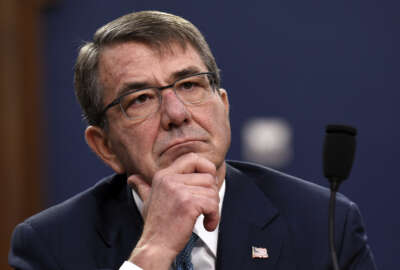
Find out what Congress is thinking on military personnel for 2017-2018
House Armed Services Committee aides say they want to keep a close eye on the personnel reforms put in place by the 2017 NDAA.
Under the Obama administration, Congress mostly relied on the executive branch to maneuver within its authorities to deal with military personnel issues, and only stepping in when needed.
House Armed Services Committee aides say that mentality doesn’t look like it will change despite a new congressional session, a fresh hand at the personnel subcommittee gavel and the rise of the Trump administration.
As of right now, the committee is taking a wait and see approach after enacting some pretty large legislative overhauls of the Uniform Code of Military Justice, commissary issues and TRICARE in the 2017 defense authorization act.
But as for continuing the sweeping personnel changes brought to DoD by former Defense Secretary Ash Carter and the Force of the Future, the House Armed Services Committee won’t be taking up the mantle, aides told Federal News Radio.
Force of the Future “had a lot of concepts, but not the data to back it up,” one committee aide said of the DoD reforms that expanded maternity leave, tried to make military hiring more flexible and opened service to gay and transgender people.
The aides said oversight of law implementation is just as important to the committee as legislating reforms and in 2017 it plans to keep an eye on the work from previous years.
The committee plans on holding hearings regarding changes made in the 2017 NDAA. But oversight doesn’t stop just at hearings. The aides said they are working with DoD to get information about the reforms put into place.
One aide said he closely watches quarterly reports on commissary changes from DoD. Another said he talks with DoD about the two year implementation of the Uniform Code of Military Justice.
But when it comes to bigger issues like revising the Defense Officer Personnel Management Act (DOPMA) or making more changes to TRICARE, committee aides said they don’t see it in the cards.
That’s despite at least a fledgling interest by House Armed Services Committee Chairman Mac Thornberry (R-Texas) to look into DOPMA’s role in today’s military.
The 2017 NDAA required new premiums and copays from military retirees and their beneficiaries to combat rising costs. It also expanded urgent care access by eliminating referrals and keeps urgent care clinics open until 11 p.m.
That was a step back from what the House bill originally proposed. The House bill originally required fees from active-duty military family members for care.
Committee aides said there is no interest in revisiting additional fees and that such fees are taken very seriously.
That’s despite huge growths in defense healthcare cost over the years.
The most recent Congressional Budget Office report on military healthcare from 2014 stated DoD spent $52 billion in health care for service members, retirees and their families in 2012.
“The cost of providing that care has increased rapidly as a share of the defense budget over the past decade, outpacing growth in the economy, growth in per capita health care spending in the United States and growth in funding for DoD’s base budget,” the report states.
The cost of providing health care to military and their families rose 130 percent from 2000 to 2012, the report states.
The report stated expanded benefits, medical costs of wars and the increased use of TRICARE are all causes of the cost increase.
As for DOPMA reform, numerous military experts including Tim Kane, author of the book “Bleeding Talent,” have called for it.
But committee aides said they are not convinced the data is there for a change and that the executive branch is doing enough with the power it was already given.
DOPMA’s biggest critics focus mostly on the “up or out system” forcing service members to promote up the ranks or separate from the military. Some say that system keeps creative minds and those going to school instead of deploying from staying in the military.
Committee aides say part of that issue is cultural. The promotion boards are the ones deciding who stays in. Right now it seems boards are promoting those with operational experience.
But the data may not be there either. Only the Navy conducts exit interviews with those separated from the service.
While Ash Carter wanted a smarter, more diverse force to deal with the issues of the future like cyber, Congress still wasn’t fully convinced.
“Many of these Force of the Future proposals appear to be solutions in search of a problem,” Senate Armed Services Committee Chairman John McCain (R-Ariz.) said last year. “I find it deeply disturbing that you are proposing to add expensive fringe benefits allegedly aimed at retention during a time when we are asking 3,000 excellent Army Captains to leave the service who would have otherwise chosen to remain on active duty. From my perspective, this initiative has been an outrageous waste of official time and resources during a period of severe fiscal constraints. It illustrates the worst aspects of a bloated and inefficient Defense organization.”
Committee aides said DOPMA is a broad law and DoD has plenty of room to work within it to retain and recruit the best.
One aide said it’s unlikely a DOPMA overhaul will get much consideration until the services “do their homework.”
Copyright © 2025 Federal News Network. All rights reserved. This website is not intended for users located within the European Economic Area.
Scott Maucione is a defense reporter for Federal News Network and reports on human capital, workforce and the Defense Department at-large.
Follow @smaucioneWFED




